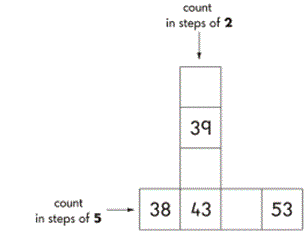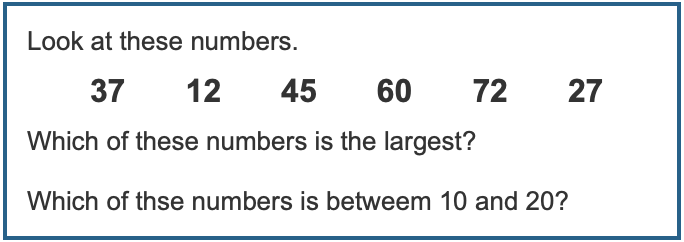| Programme of Study statements |
Activities |
| A |
B |
C |
D |
| count in steps of 2, 3, and 5 from 0, and in tens from any number, forward or backward |
|
|
|
|
| recognise the place value of each digit in a two-digit number (tens, ones) |
|
|
|
|
| identify, represent and estimate numbers using different representations, including the number line |
|
|
|
|
| compare and order numbers from 0 up to 100; use <, > and = signs |
|
|
|
|
| read and write numbers to at least 100 in numerals and in words |
|
|
|
|
| use place value and number facts to solve problems |
|
|
|
|
Activity set A
(i) You could use a counting stick to practice counting in steps of 2, 3, 5 and 10. You could also use these facts and adapt them to practice counting in steps of 20, 30, 50 and 100 and 200, 300, 500 and 1000 etc. You could ask questions as if the counting stick was a number line, for example:
- What would go on this division?
- What would go half way between these divisions?
(ii) You could give each child a paper clip and a strip of paper that has been divided into ten sections as below:

Tell them that at one end is zero and at the other is 30. Ask them to tell you what they need to count in to get from zero to 30. Next ask them to show you where different multiples of three would go, for example 27, 18, 9. The children put their paper clip on the line that shows where the number you call out will go.
(iii) You could draw a Venn diagram on the board with two interlocking circles. Start writing multiples of 3 in one circle and five in the other until the children can tell you what the numbers in each circle have in common. They could then suggest numbers that go in each circle, in the middle and outside the circles.
(iv) You could set number problems, for example, give a series of clues that involve counting in steps of different sizes. The children try to identify your ‘mystery’ number from the clues you give, for example:
- If you count in 5s you will reach my number
- It is an odd number
- It is larger than 20 but smaller than 30
You could ask the children to make up some of their own for a partner to solve.
Activity set B
The children need to develop their concept of place value. Many teachers think that if children can partition numbers into tens and ones then they understand this concept. This is not necessarily the case. There are four aspects of number value that children need to understand. These are:
- Positional: The digit 2 is in the tens position and the digit 7 is in the ones
- Multiplicative: The digit 2 is two tens (10 x 2) which is 20, the digit 7 is seven ones (1 x 7) which is 7
- Additional: combine the two numbers to make the whole by addition 20 + 7 = 27
- Base10: the value of the digits increase or decrease by the power of 10 as they get bigger or smaller
You could make simple grids like this for the children to use in class and work through the ’big ideas’ of place value (in simple terms) as they make numbers to explore using digit cards. It would be a good idea to include a 100s column in your grids. Encourage the children to write the additional number sentence in figures and then the total in words. You could ask them to think of reasons why writing the number in words can help their understanding of place value.
The children should explore partitioning numbers in different ways, for example, 58 as 50+ 8, 40 + 18, 30 + 28, 20 + 28, 10 + 38.
Activity set C
It is really important that the children are given plenty of opportunities to identify and represent numbers using different representations. You could ask the children to show you, for example, 46 using:
- Bead strings (4 groups of 10 and 6 singles)
- Base 10 apparatus (4 tens sticks and 6 cubes)
- Straws (4 bundles of 10 and singles)
- Money (four 10 pence and seven 1 pence coins)
- Two different coloured counters, one representing 10s and the other ones
Once they have done this practically ask them to show how to make the number on a number line: jump of 40 and then 6.
You could ask the children to make a selection of numbers using the representations above. Once they have ask them to order them onto a number line and compare pairs using < and >. You could also ask them to choose pairs of their numbers and make number sentences using = where they need to work out a missing number to make the number sentence correct, for example: 46 = 13 + ?
Activity set D
You could give the children problems such as these to solve:
- Harry had 6 bundles of10 straws and 7 single straws. How many straws did he have altogether?
- Hamish had five 10p coins and 3 pennies. How much money did he have altogether?
- Sandy had 37 pennies. He wanted to change them into other coins. What are the fewest coins that he could use?
- Suzie made some cakes. She put them on plates in groups of 10. She had 8 full plates and 7 cakes left over. How many cakes did she have altogether?




